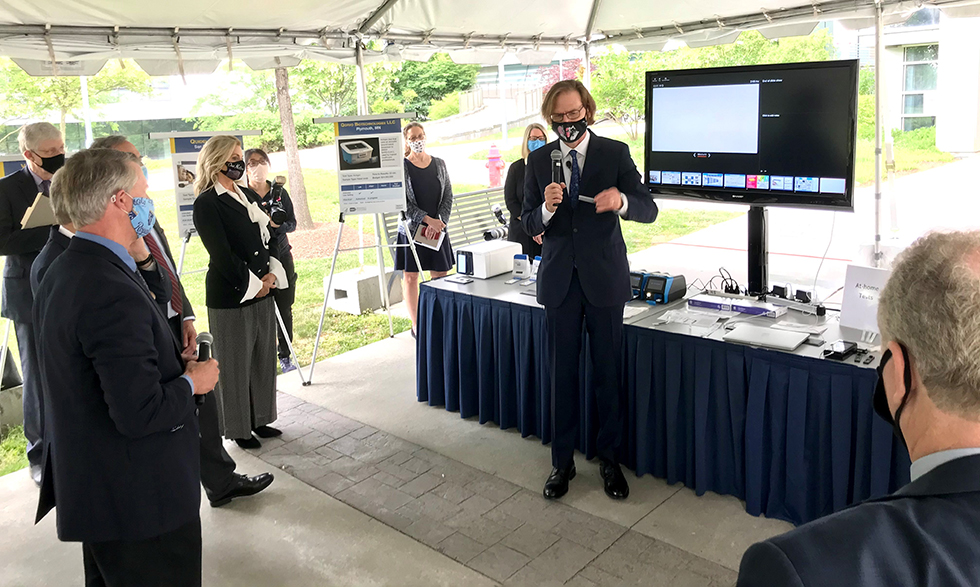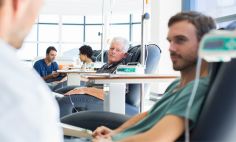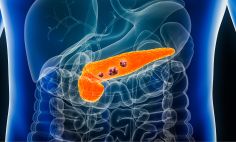
Bruce J. Tromberg, Ph.D., Director of the NIBIB
Bruce J. Tromberg, Ph.D., has been the Director of the National Institute of Biomedical Imaging and Bioengineering (NIBIB) since January 2019. Dr. Tromberg uses the science of optics and photonics (light and light-based technologies) to develop new techniques for biomedical imaging and therapy. Dr. Tromberg spoke with NIH MedlinePlus Magazine in early 2020, and now he’s sitting down with us again to talk about his love of lasers, the light-speed advances in optics and photonics he’s witnessed and contributed to throughout his career, and the unique role that NIBIB has played in NIH’s COVID-19 response.
What drew you to optic and photonic technologies?
I first became interested in lasers and optics in the 1970s when I was an undergrad. Lasers were pretty new at the time, and I thought they were really cool. Here was something that didn’t happen in nature, and you could blow stuff up with them!
I was obsessed with optics and photonics―what is light? How do you create it? How do you make it so intense that it can blow things up or burn a hole through things or measure the presence of something with a high degree of accuracy? One of the first things that people did with lasers was measure how far the moon really is from the earth. You can just shine a laser and bounce it off the moon, and you can do some pretty cool calculations.
Laser technology is one of the most transformative inventions and an incredibly fast-moving area of science. No one knew how laser lights would be used when they were first invented. Scientists had predicted how they could work in theory, but it took decades to happen. Fast forward to today and, thanks to advances in computing and optics and photonics technologies, lasers have gone from a relatively rare, specialized technology to something that’s deeply embedded in our daily lives. They have completely changed how we communicate and how we transfer information from place to place. Without lasers, we wouldn’t have video chat, the internet, or technologies like LEDs and digital cameras.
How did your work in optics and photonics lead you to biomedicine and biomedical engineering?
I was lucky to be in the right place at the right time, in a field that was growing, and using a technology that was changing quickly. I came in with lasers, optics, and fiber optics (which take light from one place to another), but my gateway to biology was in cancer at the National Cancer Institute’s biomedical imaging program. Cancer was one of the first areas [in medicine] to really embrace imaging technology development.
I also got involved in other areas of medicine―cardiovascular disease, neuroscience, metabolic disease, sports medicine―because a biomedical engineering perspective sees the body as an interconnected system made up of fundamental elements. We don’t look at them in isolation.
We could adapt these technologies for medicine and biology―microscopes, imaging, therapies―but in the early days, the commercial driver was the internet and telecommunication.
Computers were mechanical machines at first. As they became electronic and miniaturized, it opened the door for personal computers. The internet resolved how you get all these things to talk to one another. At the most fundamental level, most communication systems are driven by dots and dashes (think of Morse code). Lasers can send exquisitely short pulses of light at an incredibly fast rate. This means you can stack a whole bunch of pulses, which allows you to fit hundreds of millions of conversations into a single fiber optic cable. And that’s how I think, so I started applying those same principles to cancer and looking at ways to selectively activate or deactivate different molecules in the body.
How are the fields of bioimaging and biomedical engineering evolving?
Imaging technologies like MRIs, CT scans, and ultrasounds are advancing in really cool ways. Thanks to optics and photonics, there has been a huge revolution in microscopes, cameras, and different optical techniques that allow for things like minimally invasive surgeries and diagnostic techniques. We can put a device inside you (called an endoscope) to diagnose disease and guide surgeries. We have something called exogenous contrast agents, which are molecules and particles that you can put inside the body intravenously to identify things like tumors or neurodegenerative diseases.
Nuclear imaging is another promising area of development. In the bioimaging and biomedical engineering field, we ask the kinds of questions that can make the impossible, possible. I think many people would love to get into a scanner once a year just to know, “Am I getting Alzheimer’s? Do I have a tumor?” As nuclear imaging technology advances and becomes safer, we hope this will become possible.
I think people sometimes take these things for granted. But the blue LED, for example, took decades to develop and enabled a new generation of bright, energy-efficient white light bulbs and color LED screens. The scientists who developed it had to put atoms together in a lattice structure, which does not exist in nature, and they won a Nobel prize. So that's the basis of a lot of this stuff. You put things together that are just not natural. And I’ve lived through and been fortunate to contribute to some of these advances in the biomedical space.
What is NIBIB, and what is its role within NIH?
NIBIB is a home for the people who are developing the kinds of technologies that are not primarily driven by biological hypotheses. It has a fascinating origin story: In the 1990s, bioengineering was such a fast-moving field that Congress commissioned a study to assess its activities and impacts across both the country and NIH. Based on that study, an external panel recommended that NIH form a separate institute dedicated specifically to bioengineering. Instead, NIH wanted to weave bioengineering throughout the other institutes. Then a miracle occurred, and in 2000, President Clinton signed the National Institute of Biomedical Imaging and Bioengineering Establishment Act, which required NIH to establish a separate institute focused on bioengineering.
You know when you’re driving a car and the check engine light comes on, and everyone looks around and goes, “Does anybody know what that means?” We’re the community that says, “Yeah, we know what that means. And we can fix it.”
What impacts does biomedical engineering have on research at NIH?
On the one hand, you have the more classic biomedical research that studies, measures, and perturbs. But as biomedical engineers, we kind of live at the interface between the animate and inanimate worlds. We are trying to understand the engineering and physical science characteristics of life processes. Once you get a better understanding of where your signals come from, what the signatures are, and what they're reflective of, then you can start to pursue entirely new hypothesis-based research. You can start to see things that were never seen before.
There’s this game I like to play. I say, “Close your eyes and think of the most cutting-edge technology you can imagine.” And I think most people are thinking about the latest iPhone or maybe a cool organic LED. But when my community thinks about that stuff, we think about electrons and photons moving around from place to place—that is, creating energy, making and controlling new devices, and using energy to cure disease or to restore movement, voice, or brain function. When I play this game with other IC Directors, I tell them, “Some questions can't be answered by the technology that’s currently available, but if our communities engage, we can start to address these questions. We can build technologies for your purpose, and you can apply it in different ways.”
When did you make the move to public service?
I came on as NIBIB Director in January of 2019, and it was good timing because it was just before the pandemic. If I had come on in January of 2020, I would have been completely disoriented. But I was lucky. I got to know where Building 31 is; I know where my parking spot is.
Can you describe NIBIB’s role in responding to the COVID-19 pandemic?
When we saw the direction things were going with the pandemic, Francis [Collins, M.D., Ph.D.] brought together NIH leadership and IC Directors to brainstorm what we were going to do and what everyone could contribute. In a sense, that was pretty easy for us because there were some really big gaps. We needed to create a screening and surveillance system with regular testing for everyone in the country, the tests needed to be accurate and accessible, and we needed them fast.
In late April, Congress gave NIH $1.5 billion to advance testing within five to six months. From that moment, it was like we were sending out a call for help and everyone came on board. Five days later, we launched the Rapid Acceleration of Diagnostics (RADx®) initiative, and we created a formalized rapid review process called the “innovation funnel”―kind of like Shark Tank.
In April of 2020, the country was doing about 7 million [COVID] tests in the entire month. To get a test, you needed to be symptomatic, and you needed a prescription from a doctor. Now you can buy rapid COVID-19 tests at most pharmacy retail stores.
In a pandemic, you can’t predict what the next crisis or need will be, so we have become the flexible architecture that responds to needs as they arise, and we’ve been able fill a really critical national need by being a fluid kind of first responder for tech development. It’s been so transformational for us and for the country. And one of the most incredible experiences I’ve had in my career.
How can NIBIB continue to leverage the infrastructure and lessons learned from the COVID-19 pandemic response?
We’ve built up multiple programs through our RADx® Tech and RADx® Advanced Technology Platforms (ATP) that can, for example, assess how tests work and study the impacts of different variants. We prototyped the first direct-to-consumer Say Yes! COVID Test program, which ended up going to multiple cities all around the country. We also launched the Medical Imaging and Data Resource Center, which is a national network of leading medical imaging organizations that is using medical image-based artificial intelligence to understand and optimize images for diagnosis and prognosis.
Moving forward, we can use the infrastructure we created with RADx Tech as a permanent structure that develops and advances new testing technologies, and makes sure they work well and are responsive to other threats, pathogens, and diseases.
What initiatives does NIBIB support that aim to diversify the biomedical engineering workforce?
NIBIB is made up of 180 different departments of bioengineering and imaging programs around the country, and we are a very intellectually diverse community with backgrounds in chemistry, physics, math, biology, and medicine. These values are both embedded and aspirational for our community, and we are working hard to create new mechanisms for attracting and supporting an even more diverse and inclusive workforce. This includes creating an entirely new center called the trans-NIH Center for Biomedical Engineering and Technology Acceleration (BETA Center), which will be aligned with values of our community.
During the pandemic, what have you done in your little free time?
For our community, the pandemic―especially during the first year and a half to two years―has been like a fire drill.
I was able to launch my biomedical optics lab in the Eunice Kennedy Shriver National Institute of Child Health and Human Development building, along with two outstanding biomedical engineers I convinced to leave California and join me here: my lab director, Brian Hill, and staff scientist, Tim Quang, Ph.D.
I also built a gym in my basement. It’s a good retreat.







